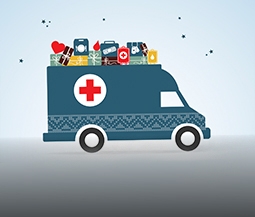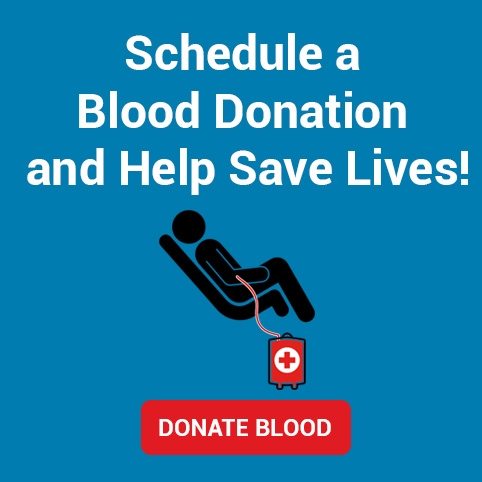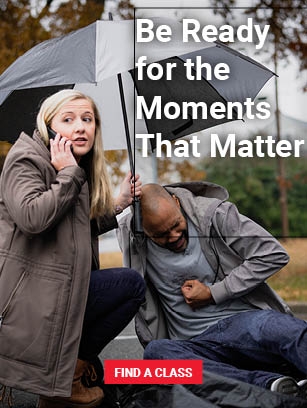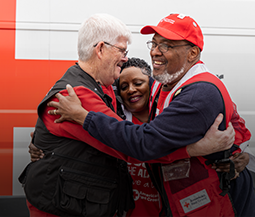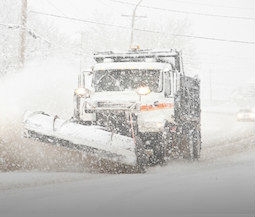Nestled high in the mountains of Barranquitas, Puerto Rico, the old-timers in Barrio Barranca told American Red Cross volunteers they’ve never seen anything like Hurricane Maria in all their years.
“Never have we taken handouts,” Marcelino Rivera Guzman, 82, and his wife lamented as they gratefully accepted cases of water, food, peanut butter crackers and hugs. “We worked hard all our lives for everything we have, but now… well, what’s the point in even talking about it?”
Red Cross workers, however, are all trained in psychological first aid and know that “talking about it” is precisely what will help lift the weary spirits of people coping with their seventh consecutive week without running water or electricity and scant access to services other United States citizens take for granted.
“Maria ended everything- the entire harvest is gone, and all the wooden houses in the hills… gone.” Mr. Rivera’s eyes filled with tears as he lifted his gaze towards the steep mountains surrounding their home, where he often hiked with his bride of 60 years. “My grandmother lived to see 107 years,” Mr. Rivera said, “Will I live that long in these conditions? I wonder.”
“I remember Santa Clara when my daughter was just a little girl,” Carmen Lydia Montecina Rivera, 80, Mr. Rivera’s wife said, referring to the local name for Hurricane Betsy of 1958. “Santa Clara destroyed part of our home, but at least we could find food. Even Hugo wasn’t like this.” In 1989, Hurricane Hugo, like Hurricane Maria, wiped out banana and coffee crops.
Monster hurricanes leave an indelible imprint. People here name them to mark the passage of time; it’s like knowing where you were on 9/11. “There are no bananas. No plantains,” Mrs. Rivera said. Plantains, related to bananas, need to be cooked. They are a Caribbean staple prepared in endless delicious ways. Fruit tress of every kind have been decimated on the island, impacting food availability and income sources for years to come. Banana family crops will take a year to recover. Locals say that mature avocado trees will likely take five years to bear fruit again, if they survived at all as Hurricane Maria completely upended many productive trees.
“Ay, there is no comparison to what Maria did to Puerto Rico,” said Teresa Rosado Ortiz, 86, as her doting family gave her a chair in the shade near the relief distribution line. A Red Cross volunteer personally delivered a case of drinking water and boxes of food to her side.
“Do you know how to prepare the militares, grandmother?” Winnie Romeril, a Red Cross volunteer from upstate New York asked her. “Militares” (militaries) are the local name for the 2000 calorie pre-packaged meals commonly eaten by soldiers. “Yes, I know how,” she said. “You put a little water in the plastic bag and put it in the cardboard box and then it gets hot. Thank you for these supplies. Thank you.”
Red Cross volunteers make sure people know how to heat the main dish as the instructions are only printed in English. Asked about her health, Mrs. Ortiz said, “I have a bad heart.” The Red Cross volunteer winked and assured her, “No. I’m sure you have a very good heart,” which earned her a laugh.
In Puerto Rico, emergency relief efforts continue with a strong sense of urgency. Red Cross teams are in the field daily, distributing life-sustaining food and water, and providing home visits for health and mental health needs to island residents. The Red Cross team who helped the Riveras and Mrs. Ortiz recently in Barranquitas, also served 1,582 people in the communities of Maná, Cañaboncito and Lajitas.
Simultaneously that day, Red Cross teams delivered supplies to 17 other affected municipalities. Many hands truly made light work in giving out water and meals plus providing medical and legal assistance in Barranquitas, thanks to help from many, including Michael Chavez Guerra and family, the Cintrón family (“El Familión”), the Fonalledas family, Pfizer (Michael Sweitzer), Chrysler (RAM Trucks of Puerto Rico and the RAM volunteers), Samaritan’s Purse and the volunteer doctors and nurses, the group of pro-bono lawyers and all the volunteers from New York.
Hurricane Maria made landfall in Puerto Rico in late September as a Category 4 storm – the most intense hurricane to hit the U.S. territory in more than 80 years. The deadly storm caused widespread destruction. In Maria’s aftermath, countless residents facing heartbreaking personal losses and challenges from damaged infrastructure. Many in Puerto Rico still have no power, phone service or safe drinking water.
WHERE YOUR DONATIONS ARE GOING
As of October 20, the Red Cross raised $31.6 million in designated donations for the Maria relief effort. All donations earmarked for Hurricane Maria will be used to support relief and recovery efforts for this disaster. Learn more about how donations are helping in this video or in our detailed report. The following are examples of how donations are being used:
Donations pay for provision and delivery of food, water and relief items, accounting for $24.2 million of our preliminary budget estimate. In the first month, the Red Cross served 1.3 million meals and snacks, and distributed more than 843,000 relief items. Donations pay for health and mental health services, accounting for $500,000 of our preliminary budget estimate. In the first month, the Red Cross provided more than 11,000 services to support and care for people.Donations pay for individual and community recovery programs, accounting for $4.1 million of our preliminary budget estimate. The Red Cross is working alongside local partners to plan for long-term recovery and helping communities rebound and prepare for future disasters. Donations pay to transport, lodge and feed thousands of trained disaster workers who work in shelters, drive food trucks, hand out relief supplies, replace medications and eyeglasses, provide emotional support and coordinate with local officials.Donations pay for the freight, warehousing and other logistics expenses that enable the Red Cross to provide food, water and the truck-loads of relief items we’ve given out. Donations pay for the equipment, maintenance and fueling of emergency vehicles and rented trucks that deliver food and relief items to people in need. Donations pay for the full-time program staff, disaster information technology, communications and call center infrastructure that make all of this help possible. Donations also pay for our management, general and fundraising expenses that support our work at its core and are indispensable to running the organization and helping people in need. They include the people and systems to maintain our enterprise-wide computer and telecommunications, HR and payroll systems to support our more than 20,000 employees and nearly 314,000 volunteers, fundraising and communications functions, and other support services across all program lines.



